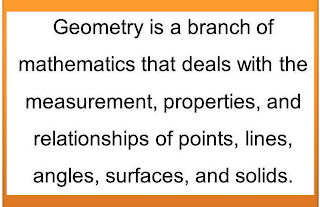LESSON PLAN OF TYPES OF ANGLES
LESSON PLANNING OF TYPES OF ANGLES
Subject Mathematics
Grade 5th
Students` Learning Outcomes
- Recall an angle and recognize acute, right, obtuse, straight and reflex angles.
Information for Teachers
- The word angle is derived from the Latin word angulus, meaning “a corner”.
- In geometry, an angle is the figure formed by two rays, called the sides of the angle.
- Acute, right, obtuse, straight and reflex angle
are few of six types of angles.
- An angle whose measures less than 900 is called acute angle.
- An angle whose measure is exactly 900
is called right angle.
- An angle whose measure is greater than 900 and less than 1800 is called obtuse angle.
- An angle whose measure is exactly 1800
is called straight angle [] straight line]
- An angle whose measure is greater than 1800
and less than 3600 is called reflex angle.
Material / Resources
Writing
board, chalk / marker, duster, geometry box, textbook
Introduction
- Take out your geometry box along and ask what is it?
- What is a geometry box?
- What is geometry?
- Why is geometry important?
- Ask students to think about why geometry is important in the “real world”. Write down any ideas that surface in the discussion; make sure that students are talking on the topics of art, architecture and engineering.
Development
Activity 1
- Provide one paper per student [try to get a better quality paper if possible]
- Ask students to fold it from middle and draw a line between.
- Label one column as KEY-WORD and other as I-KNOW.
- Draw horizontal lines so that they can write later.
- On outer side of the folded paper write ‘My Geometry Dictionary’ and your name.
- Show your personal geometry dictionary to the students and encourage them while writing new word after learning.
- Every word that students put in their dictionary will also be written on the board.
- Draw few figures, on the board, taken from Grade 4 lessons, ask students to discuss amongst each other and collect each group`s feedback verbally and produce the correct concept on board. For example;
o Alphabets ‘V’ has …………………….angle whereas ‘L’ has …………. Angle.
o Can you draw 120 degree angle by using protractor?
o What is the angle between hours and minutes hands when it is 6 o`clock, 3 o`clock, 5 o`clock and 2 o`clock etc.
- Divide the class in groups and let them find answers, this will help recall taught concepts.
Sum up / Conclusion
- Windup today`s lecture by repeating key points learned today.
- Acute, right, obtuse, straight and reflex are the types of angle.
- An angle is the figure formed by two sides.
- Angle less than 900 is called acute angle.
- An angle of 900 is called right angle.
- Greater than 900 and less than 1800 angle are called obtuse angle.
- Angle of exactly 1800 is called straight angle.
- Angle greater than 1800 and less than 3600 is called reflex angle.
Assessment
- Assign following question to the students to assess them.
- Draw the following table on the board and call students one by one and ask them to link the name of the angle with its properties.
Follow up
- Assign homework to further strengthen their concepts regarding angles, e.g.
- o Ask the students to observe your home and
point out different items at which you think form one of the angle that you
read in the class.
- o Give them hint like, corner of TV that forms
right angle (900)















Comments
Post a Comment